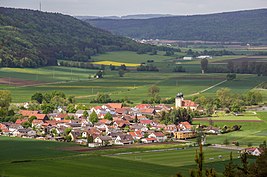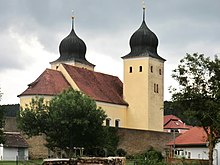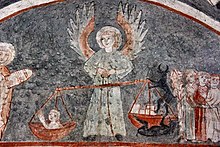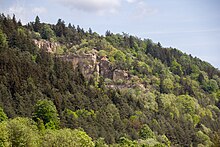Kottingwörth
|
Kottingwörth
City of Beilngries
Coordinates: 49 ° 1 ′ 8 ″ N , 11 ° 31 ′ 12 ″ E
|
|
|---|---|
| Height : | 363 (363-380) m |
| Residents : | 452 (Dec. 31, 2018) |
| Incorporation : | May 1, 1978 |
| Postal code : | 92339 |
| Area code : | 08461 |
|
View from Arzberg
|
|
Kottingwörth is a district of the town of Beilngries in the Upper Bavarian district of Eichstätt in the Altmühltal Nature Park .
location
The village is located in the Altmühltal south-east of the Beilngries parish between Leising and Töging . There are connecting roads to State Road 2230.
history
Kottingwörth is in the 6./7. Century in the course of the Bavarian land conquest. The original name of the settlement appears in medieval documents, for example in a deed of wilderness by Emperor Heinrich IV in 1080 for the Eichstätter Bishop Udalrich, as "Werde" (for "Wörth" = island), so called because of the settlement on an Altmühlinsel, which was caused by the drying up of the northern Altmühlarm was no longer recognizable as such for a long time and was only recognizable again after the renaturation measures (2004–2006). The clan of a "Kotting" will initially have settled on the flood-free valley edges and probably moved to the "Wörth" in the 9th century; Such relocations took place several times in the Altmühltal area. In 1119, a local nobility is attested for the first time with the "Lords of Werde" as an episcopal ministerial family, which can be proven until 1320. The local nobility sat in the smaller Meierhof , while the larger Meierhof ("curia villicalis maior") was given to the Rebdorf Monastery by the Counts of Hirschberg from 1296 ; in Grögling and thus within the parish of Kottingwörth, the counts sat until around 1180. Of the ministerials, Otto von Werden appears in 1129 as a witness at the foundation of the nearby Benedictine monastery in Plankstetten , in 1194 and 1209 an Ulrich is named as "Truchseß von Werde", who together with Hartwig von Werde belonged to the Eichstätter cathedral chapter .
As an episcopal nobility fief, the place came back to the Bishop of Eichstätt when the Counts of (Grögling) -Hirschberg and Gebhard VII. Died out in 1305. As is often the case in medieval bishoprics , the manor was very fragmented. In addition to the bishop, the Augustinian canons monastery Rebdorf (with patronage, which was transferred to the bishop in 1313 with the larger Meierhof), the aforementioned lords of Werde, the burgraves of Nuremberg (from 1516 the hereditary marshals of Pappenheim ), the Morsbachers and from 1404 the Plankstetten monastery exercised manorial rights. Customs rights for the Altmühlfurt and for the later bridge, over which the old salt road Reichenhall-Landshut-Nürnberg led, were owned by the Töging taverns . The efforts of the Eichstätt prince-bishops to acquire the manorial rule everywhere in their bishopric, led to the fact that in Kottingwörth almost the entire manorial estate came into episcopal ownership through purchase and exchange, most recently, at the latest in the early 17th century, the Plankstetten property. The episcopal property was administered by the Beilngries caste office . In addition, there were peasant property .
A forge is mentioned for the first time in 1407, a Taferne in 1447 and a bathhouse in 1447. The tavern was owned, the bathhouse and forge belonged to the community. In 1517 the name "Kottingen-Wer" appears for the first time in a Tögingen document. In 1622 the rectory was built. In 1644 seven episcopal farms were empty after the Thirty Years' War . At the end of the 18th century there were 36 households in Kottingwörth. Down by the court, the village formed along with eight other villages up to the secularization 1802 Oberamt Hirschberg own -Beilngries marriage detention -Sprengel.
During the secularization , the lower bishopric, to which the caste office of Beilngries and thus also Kottingwörth belonged, passed to Grand Duke Archduke Ferdinand III. from Tuscany and 1806 to Bavaria . Here Kottingwörth and the Kottingwörther Mühle formed a community in the Beilngries regional court and rent office. In 1809 Kottingwörth, Kottingwörther Mühle, Leising and Pfenninghof were merged into a tax district and from 1811 into a rural community . In 1820, the Oedhof (which had been removed in the second half of the 19th century) was added to the community by being separated from the community of Töging. From 1838 the district of Beilngries and with it the municipality of Kottingwörth was part of the district of Middle Franconia with the capital Ansbach .
On July 1, 1972, the place moved from the dissolved Upper Palatinate district of Beilngries to the expanded district of Eichstätt, which was incorporated from Middle Franconia to Upper Bavaria. With the Bavarian regional reform , Kottingwörth was incorporated into Beilngries on May 1, 1978.
In 1983 there were six full-time farms and 29 part-time farms in the village, but today there are no longer any full-time farms. From 1997 to 2000 the old school building was converted into a community center.
For the Kottingwörthermühle see there.
Catholic parish church of St. Vitus
Kottingwörth is one of the original parishes of the lower Altmühltal and the lower Hochstift. The Vitus patronage points to the 9th to 10th centuries. The parish was very extensive in the Middle Ages; in addition to the town itself, it included Dietfurt an der Altmühl (until 1540), Töging, Hainsberg , Paulushofen (until 1792) and probably Kirchbuch and Kevenhüll . Today the parish of Kottingwörth (2007 total of 542 Catholics) with its branches in Grögling, Leising and Vogelthal is looked after by pastoral care from Beilngries.
societies
- Warrior and soldier camaraderie (founded 1924)
- Voluntary fire brigade (founded 1881)
- FSV (football sports club) (founded 1949)
- Fruit and horticultural association (founded in 1995)
- Hunting association
- Theater club
- Branch of the Catholic German Women's Association
- Catholic rural youth movement
- Association for tradition and culture in Kottingwörth (VfTK) (founded in 1998)
traffic
The Kottingwörth stop was on the Neumarkt – Dietfurt railway line , which has since been closed .
Others
- Since it was built in 1910, the high water jetty has often been the only way to leave the village with dry feet during the frequent floods of the Altmühl.
- In 2014, the previously existing flood bridge was extensively renovated.
- The medieval "Stone Bridge" (illustration in Mader, Kunstdenkmäler, p. 101) was demolished in 1927/1928 as part of the Altmühl regulation. The successor bridge suffered damage caused by the war in April 1945; the current bridge was built in 1962.
- The Arzberghang lying quarry near Kottingwörth was 1938 to 1975 in operation.
literature
- Friedrich Hermann Hofmann and Felix Mader (editor): The art monuments of Upper Palatinate & Regensburg. XII District Office Beilngries. I. District Court of Beilngries. Munich: R. Oldenbourg Verlag 1908 (reprint 1982), pp. 100-108
- Felix Mader: History of the castle and Oberamt Hirschberg. Eichstätt: Brönner & Daentler 1940, pp. 198–204
- 900 years of Kottingwörth 1080-1980. Kottingwörth 1980
- The Eichstätter area past and present. 2nd Edition. Eichstätt: Sparkasse Eichstätt 1984, pp. 233–235 (with bibliography)
- Gerhard Hirschmann: Eichstätt, Beilngries-Eichstätt-Greding . In: Commission for Bavarian State History at the Bavarian Academy of Sciences (Hrsg.): Historical Atlas of Bavaria . Part Franconia, Series I, Issue 6. Munich 1959 ( digitized version )
- Wolfgang Wiessner: Hilpoltstein . In: Commission for Bavarian State History at the Bavarian Academy of Sciences (Hrsg.): Historical Atlas of Bavaria . Part Franconia, Series I, Issue 24. Munich 1978, ISBN 3-7696-9908-4 ( digitized version ).
- Emanuel Braun: fortified church St. Vitus Kottingwörth . Regensburg: Schnell & Steiner 1985, new edition 2008
- Josef Wittmann: Village community saves cultural property [= hit barn] in Kottingwörth . In: Das Jura-Haus, No. 12 (2006), pp. 83-88
- Josef Wittmann: Festschrift 125 years of the Kottingwörth volunteer fire brigade with the inauguration of the new fire station 18.05. until May 21, 2006 . Kottingwörth 2006
Individual evidence
- ↑ Beilngries: Paulushofen remains the largest village - A look at the districts: Strong population growth in Aschbuch, Wolfsbuch, Kevenhüll and Wiesenhofen. Donaukurier, January 4, 2019, accessed on January 5, 2019 .
- ^ Federal Statistical Office (ed.): Historical municipality directory for the Federal Republic of Germany. Name, border and key number changes in municipalities, counties and administrative districts from May 27, 1970 to December 31, 1982 . W. Kohlhammer, Stuttgart and Mainz 1983, ISBN 3-17-003263-1 , p. 599 .




